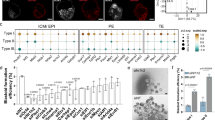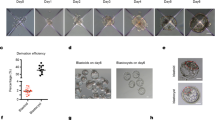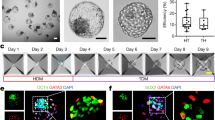Abstract
The derivation of embryonic stem (ES) cells by nuclear transfer holds great promise for research and therapy but involves the destruction of cloned human blastocysts. Proof of principle experiments have shown that ‘customized’ ES cells derived by nuclear transfer (NT-ESCs) can be used to correct immunodeficiency in mice1. Importantly, the feasibility of the approach has been demonstrated recently in humans2, bringing the clinical application of NT-ESCs within reach. Altered nuclear transfer (ANT) has been proposed as a variation of nuclear transfer because it would create abnormal nuclear transfer blastocysts that are inherently unable to implant into the uterus but would be capable of generating customized ES cells3. To assess the experimental validity of this concept we have used nuclear transfer to derive mouse blastocysts from donor fibroblasts that carried a short hairpin RNA construct targeting Cdx2 . Cloned blastocysts were morphologically abnormal, lacked functional trophoblast and failed to implant into the uterus. However, they efficiently generated pluripotent embryonic stem cells when explanted into culture.
This is a preview of subscription content, access via your institution
Access options
Subscribe to this journal
Receive 51 print issues and online access
$199.00 per year
only $3.90 per issue
Buy this article
- Purchase on SpringerLink
- Instant access to full article PDF
Prices may be subject to local taxes which are calculated during checkout



Similar content being viewed by others
References
Rideout, W. M. III, Hochedlinger, K., Kyba, M., Daley, G. Q. & Jaenisch, R. Correction of a genetic defect by nuclear transplantation and combined cell and gene therapy. Cell 109, 17–27 (2002)
Hwang, W. S. et al. Patient-specific embryonic stem cells derived from human SCNT blastocysts. Science 308, 1777–1783 (2005)
Hurlbut, W. B. Altered nuclear transfer as a morally acceptable means for the procurement of human embryonic stem cells. Perspect. Biol. Med. 48, 211–228 (2005)
Chawengsaksophak, K., de Graaff, W., Rossant, J., Deschamps, J. & Beck, F. Cdx2 is essential for axial elongation in mouse development. Proc. Natl Acad. Sci. USA 101, 7641–7645 (2004)
Strumpf, D. et al. Cdx2 is required for correct cell fate specification and differentiation of trophectoderm in the mouse blastocyst. Development 132, 2093–2102 (2005)
Ventura, A. et al. Cre-lox-regulated conditional RNA interference from transgenes. Proc. Natl Acad. Sci. USA 101, 10380–10385 (2004)
Chawengsaksophak, K., James, R., Hammond, V. E., Kontgen, F. & Beck, F. Homeosis and intestinal tumours in Cdx2 mutant mice. Nature 386, 84–87 (1997)
Eggan, K. et al. Hybrid vigor, fetal overgrowth, and viability of mice derived by nuclear cloning and tetraploid embryo complementation. Proc. Natl Acad. Sci. USA 98, 6209–6214 (2001)
The President's Council on Bioethics. Alternative sources of human pluripotent stem cells. [Online] http://www.bioethics.gov (2005).
Melton, D. A., Daley, G. Q. & Jennings, C. G. Altered nuclear transfer in stem-cell research—a flawed proposal. N. Engl. J. Med. 351, 2791–2792 (2004)
Jaenisch, R. Human cloning—the science and ethics of nuclear transplantation. N. Engl. J. Med. 351, 2787–2791 (2004)
Brambrink, T., Hochedlinger, K. & Jaenisch, R. Gene expression in embryonic stem cells from cloned and fertilized embryos. Proc. Natl. Acad. Sci. USA (submitted).
Adjaye, J. et al. Primary differentiation in the human blastocyst: Comparative molecular portraits of inner cell mass and trophectoderm cells. Stem Cells published online 4 August 2005 (doi:10.1634/stemcells.2005-0113)
Hyslop, L. A. et al. Downregulation of NANOG induces differentiation of human embryonic stem cells to extraembryonic lineages. Stem Cells 23, 1035–1043 (2005)
Pfeifer, A., Ikawa, M., Dayn, Y. & Verma, I. M. Transgenesis by lentiviral vectors: lack of gene silencing in mammalian embryonic stem cells and preimplantation embryos. Proc. Natl Acad. Sci. USA 99, 2140–2145 (2002)
Hacein-Bey-Abina, S. et al. LMO2-associated clonal T cell proliferation in two patients after gene therapy for SCID-X1. Science 302, 415–419 (2003)
Wakayama, S. et al. Establishment of male and female nuclear transfer embryonic stem cell lines from different mouse strains and tissues. Biol. Reprod. 72, 932–936 (2005)
Wang, Z. & Jaenisch, R. At most three ES cells contribute to the somatic lineages of chimeric mice and of mice produced by ES-tetraploid complementation. Dev. Biol. 275, 192–201 (2004)
Acknowledgements
We would like to thank K. Hochedlinger and L. Jackson-Grusby for discussion and critical reading of the manuscript, and in particular D. Fu for sections and stainings. We are also grateful to B. Hogan and P. Berg for critical comments on the manuscript. R.J. was supported by NIH/NCI grants. A.M. was supported by a Boehringer Ingelheim Fonds (BIF) PhD fellowship. Author Contributions R.J. and A.M. conceived and designed the experiments, A.M. performed the experiments, R.J. and A.M. wrote the paper.
Author information
Authors and Affiliations
Corresponding author
Ethics declarations
Competing interests
Reprints and permissions information is available at npg.nature.com/reprintsandpermissions. The authors declare no competing financial interests.
Supplementary information
Supplementary Figure 1
Selection of functional shRNAs. Knockdown efficiency of each shRNA (see Methods for design of shRNAs) was tested using a DsRed reporter construct. (PDF 2290 kb)
Supplementary Figure 2
Knockdown of endogenous Cdx2. The knockdown efficiency of the shRNA selected by the reporter assay (Supplementary Fig. 1) against endogenous Cdx2 was tested using ZHBTc4 ES cells. (PDF 734 kb)
Supplementary Figure Legends
Text to accompany the above Supplementary Figures. (DOC 23 kb)
Rights and permissions
About this article
Cite this article
Meissner, A., Jaenisch, R. Generation of nuclear transfer-derived pluripotent ES cells from cloned Cdx2-deficient blastocysts. Nature 439, 212–215 (2006). https://doi.org/10.1038/nature04257
Received:
Accepted:
Published:
Issue date:
DOI: https://doi.org/10.1038/nature04257
This article is cited by
-
The role of Wnt/β-catenin-lin28a/let-7 axis in embryo implantation competency and epithelial-mesenchymal transition (EMT)
Cell Communication and Signaling (2020)
-
Establishment of bovine embryonic stem cells after knockdown of CDX2
Scientific Reports (2016)
-
Techniques of Human Embryonic Stem Cell and Induced Pluripotent Stem Cell Derivation
Archivum Immunologiae et Therapiae Experimentalis (2016)
-
How can ethics relate to science? The case of stem cell research
European Journal of Human Genetics (2013)
-
Forschung mit humanen embryonalen Stammzellen in Deutschland
Gynäkologische Endokrinologie (2012)



